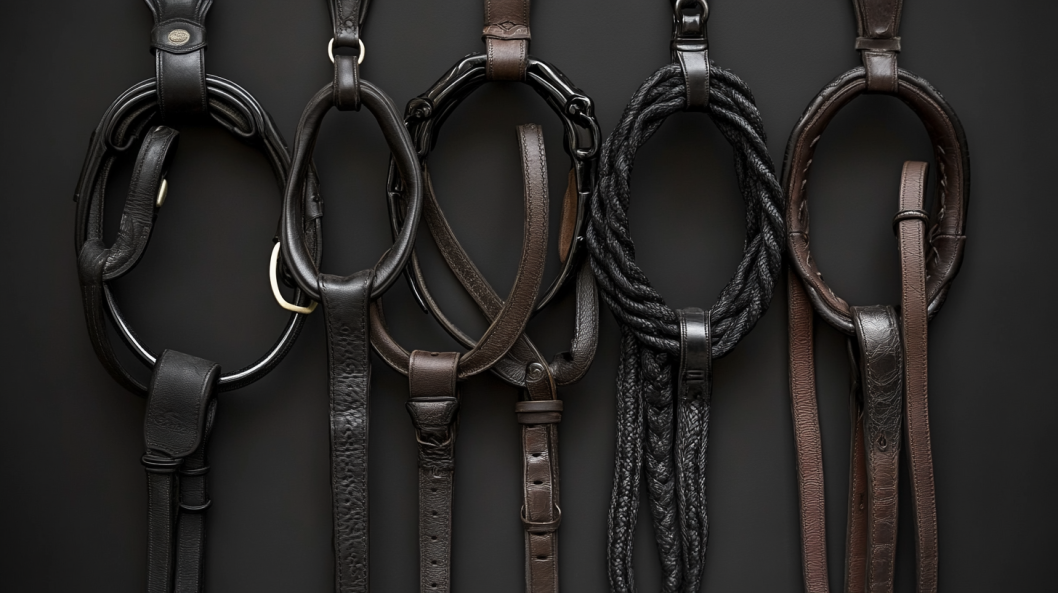When it comes to equestrian gear, the bridle is one of the most critical pieces of equipment for a rider and their horse. It influences the horse’s comfort and affects communication and control. Understanding the materials used in bridles can help you choose the right one for your needs and preferences.
I believe that choosing the right bridle material is more than just a matter of preference—it’s about enhancing the overall experience for both the rider and the horse. The bridle material plays a crucial role in the horse’s comfort, the rider’s control, and the overall effectiveness of communication between horse and rider. With so many options available, it’s important to understand each material’s distinct qualities and benefits to make an informed decision that suits your specific needs and preferences. This post will explore the materials commonly used in bridles and discuss their advantages and considerations.
Leather
Overview: Leather is the traditional material used for bridles and remains a popular choice due to its durability and classic appearance. High-quality leather bridles are typically made from full-grain leather, known for its strength and suppleness.
Advantages:
- Durability: Leather bridles, especially those made from full-grain leather, can last many years with proper care.
- Comfort: Leather molds to the horse’s head over time, providing a custom fit and reducing the risk of pressure points.
- Aesthetic Appeal: Leather has a timeless, elegant look that many riders and show enthusiasts prefer.
Considerations:
- Maintenance: Leather requires regular cleaning and conditioning to prevent it from drying out and cracking.
- Cost: High-quality leather bridles can be more expensive than other materials.
Synthetic Materials
Overview: Synthetic materials, such as synthetic leather or nylon, are becoming increasingly popular due to their affordability and ease of maintenance. These materials are designed to mimic the look and feel of traditional leather.
Advantages:
- Low Maintenance: Synthetic bridles are generally easy to clean and do not require conditioning like leather.
- Affordability: Synthetic options are often less expensive than their leather counterparts.
- Variety: Available in a range of colors and styles, synthetic bridles can offer a modern look and feel.
Considerations:
- Durability: While many synthetic bridles are quite durable, they may not last as long as high-quality leather.
- Comfort: Synthetics and leather may not mold to the horse’s head, potentially leading to less comfort.
Nylon
Overview: Nylon bridles are known for their strength and are often used for everyday riding and training. They come in a variety of colors and styles.
Advantages:
- Durability: Nylon is highly resistant to wear and tear, making it a good choice for frequent use.
- Easy Care: Nylon bridles can be easily washed and dried, requiring minimal maintenance.
- Cost-Effective: Typically more affordable than leather options.
Considerations:
- Less Custom Fit: Nylon does not conform to the horse’s head like leather does, which might affect comfort.
- Appearance: Some riders prefer the traditional look of leather over nylon.
Rubber
Overview: Rubber bridles are less common but are valued for their unique properties. They are often used in specific disciplines or for particular needs.
Advantages:
- Grip: Rubber provides a non-slip surface, which can be beneficial in certain conditions.
- Comfort: Rubber can be more forgiving and less likely to irritate, especially in sensitive horses.
Considerations:
- Special Use: Rubber bridles are not as versatile as leather or synthetic options and may not be suitable for all disciplines.
- Maintenance: Rubber can become sticky or attract dust, requiring regular cleaning.
In my view, the material of a bridle significantly influences both the horse’s well-being and the rider’s effectiveness. While leather remains a timeless choice for its durability and classic aesthetic, synthetic and nylon options offer practical benefits in terms of cost and maintenance. Rubber, though less conventional, has its niche uses that can be highly effective. Ultimately, the best bridle material is the one that meets your specific needs and enhances your riding experience. By considering the pros and cons of each material, you can make a decision that aligns with both your practical requirements and personal preferences.





